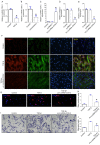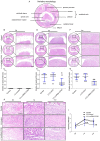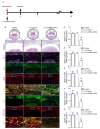LncRNA-COX2 inhibits Fibroblast Activation and Epidural Fibrosis by Targeting EGR1
- PMID: 35280679
- PMCID: PMC8898373
- DOI: 10.7150/ijbs.67974
LncRNA-COX2 inhibits Fibroblast Activation and Epidural Fibrosis by Targeting EGR1
Abstract
Rationale: Epidural fibrosis is one of the contributors to failed back surgery syndrome (FBSS) with a high incidence of about 80,000 cases per year. The fibrosis spreads from the operative region to the dura mater or the nerve root and results in functional incapacity and pain after laminectomy. Our previous study showed that down-regulation of lncRNA-COX2 is involved in the epidural scar formation. However, it remains unknown whether lncRNA-COX2 participate in the fibroblast activation and epidural fibrogenesis. Methods: LncRNA-COX2 and EGR1 expression were assessed by qRT-PCR and western blotting. Fibroblasts differentiation, proliferation and migration was determined by Collagen I/ɑ-SMA, 5-ethynyl-2'-deoxyuridine (EdU) and Transwell Assay respectively. Luciferase reporter assay was performed for the verification of target of LncRNA-COX2. Laminectomy was performed to establish the model of epidural fibrosis in mice. Epidural scar was evaluated by hematoxylin and eosin (HE) staining and Masson Trichrome staining. Results: Based on the result of transcriptome profiling, we found LncRNA-COX2 was significantly decreased in epidural tissues after laminectomy and in activated fibrotic fibroblasts. In vitro, overexpression of LncRNA-COX2 suppressed epidural fibrogenesis by inhibiting fibroblasts differentiation, proliferation and migration. Mechanistically, LncRNA-COX2 functioned as competing endogenous RNA (ceRNA) of EGR1. Gain of LncRNA-COX2 significantly decreased the expression of EGR1 and showed anti-fibrotic effect while EGR1 was markedly increased after loss of LncRNA-COX2. In vivo, LncRNA-COX2 attenuated laminectomy-induced epidural fibrosis in mice. Conclusion: In summary, the results demonstrated that LncRNA-COX2 showed anti-fibrotic effect by targeting EGR1 and identified LncRNA-COX2 as therapeutic molecule for preventing aberrant epidural fibrosis.
Keywords: EGR1.; Epidural Fibrosis; Fibroblast Activation; LncRNA-COX2; laminectomy.
© The author(s).
Conflict of interest statement
Competing Interests: The authors have declared that no competing interest exists.
Figures








Similar articles
-
Potential roles of lncRNA-Cox2 and EGR1 in regulating epidural fibrosis following laminectomy.Eur Rev Med Pharmacol Sci. 2019 Sep;23(17):7191-7199. doi: 10.26355/eurrev_201909_18820. Eur Rev Med Pharmacol Sci. 2019. PMID: 31539105
-
Taurine Reduced Epidural Fibrosis in Rat Models after Laminectomy via Downregulating EGR1.Cell Physiol Biochem. 2016;38(6):2261-71. doi: 10.1159/000445581. Epub 2016 May 19. Cell Physiol Biochem. 2016. PMID: 27188306
-
Local application of rapamycin reduces epidural fibrosis after laminectomy via inhibiting fibroblast proliferation and prompting apoptosis.J Orthop Surg Res. 2016 May 6;11(1):58. doi: 10.1186/s13018-016-0391-0. J Orthop Surg Res. 2016. PMID: 27154399 Free PMC article.
-
Apigenin inhibits fibroblast proliferation and reduces epidural fibrosis by regulating Wnt3a/β-catenin signaling pathway.J Orthop Surg Res. 2019 Aug 14;14(1):258. doi: 10.1186/s13018-019-1305-8. J Orthop Surg Res. 2019. PMID: 31412883 Free PMC article.
-
Polymeric Dural Biomaterials in Spinal Surgery: A Review.Gels. 2024 Sep 6;10(9):579. doi: 10.3390/gels10090579. Gels. 2024. PMID: 39330181 Free PMC article. Review.
Cited by
-
Metalloproteinase-2 in failed back surgery syndrome caused by epidural fibrosis: can it play a role in persistent pain?Front Hum Neurosci. 2023 Sep 19;17:1248943. doi: 10.3389/fnhum.2023.1248943. eCollection 2023. Front Hum Neurosci. 2023. PMID: 37799188 Free PMC article.
-
LncRNA FOXD1-AS1 regulates pancreatic cancer stem cell properties and 5-FU resistance by regulating the miR-570-3p/SPP1 axis as a ceRNA.Cancer Cell Int. 2024 Jan 2;24(1):4. doi: 10.1186/s12935-023-03181-5. Cancer Cell Int. 2024. PMID: 38167126 Free PMC article.
-
Feedback Regulation of sPLA2-COX/5-LOX-Ca2+ in Seminal Plasma and Its Impact on Sperm Quality Parameters.J Inflamm Res. 2025 Jun 13;18:7381-7400. doi: 10.2147/JIR.S523172. eCollection 2025. J Inflamm Res. 2025. PMID: 40535354 Free PMC article.
-
Effect of Extracorporeal Shock Wave Therapy on Post-Laminectomy Lumbar Epidural Fibrosis.Ann Rehabil Med. 2025 Apr;49(2):81-90. doi: 10.5535/arm.240118. Epub 2025 Apr 30. Ann Rehabil Med. 2025. PMID: 40312273 Free PMC article.
-
Fucoidan-Mediated Inhibition of Fibrotic Properties in Oral Submucous Fibrosis via the MEG3/miR-181a/Egr1 Axis.Pharmaceuticals (Basel). 2022 Jul 5;15(7):833. doi: 10.3390/ph15070833. Pharmaceuticals (Basel). 2022. PMID: 35890132 Free PMC article.
References
-
- Fritsch EW, Heisel J, Rupp S. The failed back surgery syndrome: reasons, intraoperative findings, and long-term results: a report of 182 operative treatments. Spine (Phila Pa 1976) 1996;21:626–33. - PubMed
-
- Amirdelfan K, Webster L, Poree L, Sukul V, McRoberts P. Treatment Options for Failed Back Surgery Syndrome Patients With Refractory Chronic Pain: An Evidence Based Approach. Spine (Phila Pa 1976) 2017;42(Suppl 14):S41–52. - PubMed
-
- Samy AM, Hardy RJ. Epidural fibrosis and the failed back surgery syndrome: history and physical findings. Neurol Res. 1999;21(Suppl 1):S5–8. - PubMed
-
- Zhang C, Kong X, Ning G, Liang Z, Qu T, Chen F, Cao D, Wang T, Sharma HS, Feng S. All-trans retinoic acid prevents epidural fibrosis through NF-kappaB signaling pathway in post-laminectomy rats. Neuropharmacology. 2014;79:275–81. - PubMed
Publication types
MeSH terms
Substances
LinkOut - more resources
Full Text Sources
Research Materials

